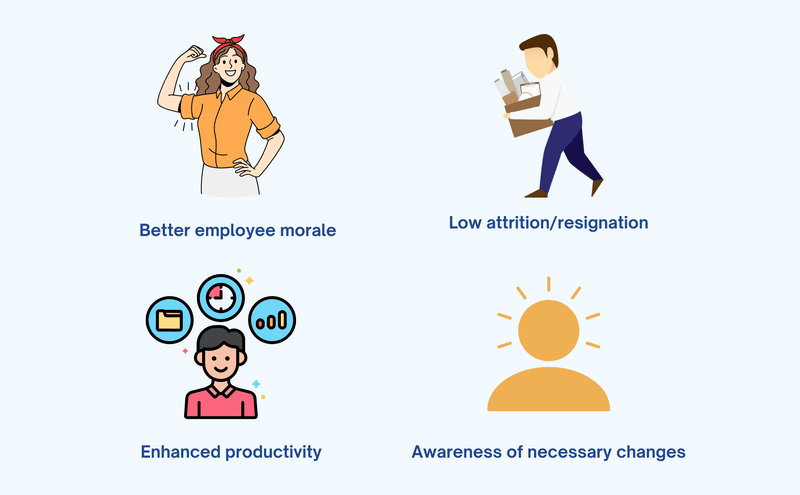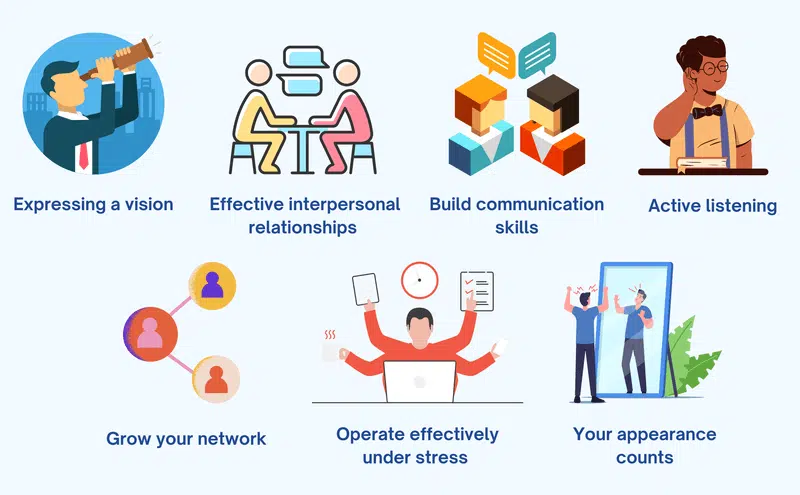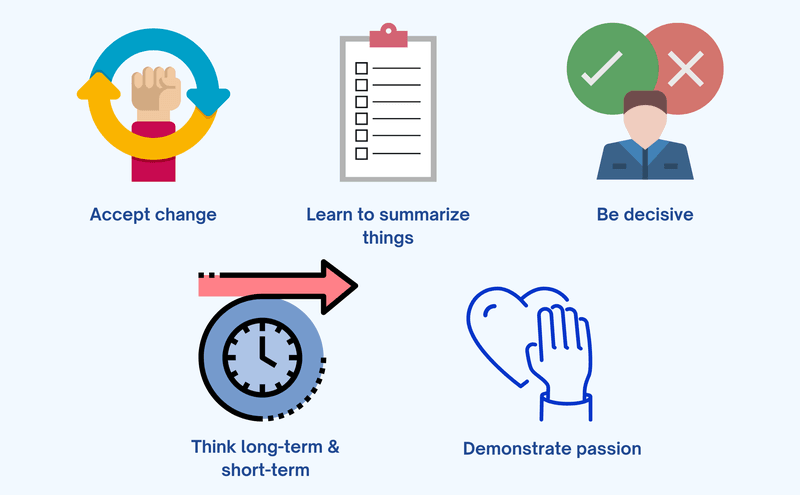Executive presence – This word has a fundamental and official tone. However, it is not something that is the sole right of the senior leadership of a firm. It is a trait that is necessary for this day and age. Executive presence is essential, but it does not have to be enigmatic. Most significantly, executive presence is a talent, not a personality attribute, which can be harnessed and developed.
Here's a simple explanation of executive presence. What it is, why you need it, how to obtain it, and much more.
Table of Contents
- What Is Executive Presence?
- Is Leadership Presence the same as Executive Presence?
- Why Is Executive Presence Important?
- How to Develop an Executive Presence?
- How to Improve Executive Presence?
- How To Practice Executive Presence?
- How to Have Executive Presence Virtually?
- Executive Presence Examples
What Is Executive Presence?
Executive presence may mean many things to different individuals. However, defined, it comes from being real. Also, it is a process of instilling confidence in others and encouraging them to take impactful action.
Leadership, and especially creating your executive presence, is a process of personal development of:
- Who you are
- The type of leader you are
- And the kind of leader you aspire to be.
A person with a high degree of dynamism is someone with an excellent executive presence. Executive presence is also about maintaining poise and grace under pressure. It is the ability to carry oneself confidently and bring value to the table.
Executive presence enables leaders to grasp the requirements of their team members about the needs of the business. It is a characteristic that allows one to be assertive. This is done through a display of confidence and effective leadership.
An executive presence consists of several distinct characteristics required for good leadership. When they come together, they form a leader who may be the driving force behind a firm. As a result, those with executive presence skills are usually in leadership positions.
Executive Presence Definition
Executive Presence is a quality that can help separate top performers from the rest. It’s an elusive yet important trait that can make all the difference in how you are seen in the workplace and beyond.
So what exactly is Executive Presence? Simply put, it’s the ability to project confidence and self-assurance with deliberate intentions. This means having a clear vision of what you want to achieve, communicating it effectively, and having the knowledge and skillset necessary to execute it successfully. Executives who have mastered this quality come across as savvy, credible leaders who inspire trust in their peers and followers. They show charisma when presenting ideas or making decisions; they exude poise under pressure; they embody professionalism at all times; and they present themselves with authority without being overbearing or intimidating.
Is Leadership Presence the same as Executive Presence?
Yes! Leadership presence is an integral part of executive presence. As any seasoned executive will tell you, having a leadership presence separates great leaders from the rest. The ability to confidently and effectively lead, motivate, and inspire others makes a great leader stand out from the crowd.
Leadership presence involves more than just knowledge and experience; it’s about having the right attitude, communication style, body language, vocal tone, and overall demeanor to command respect and attention in any situation. It’s about thinking on your feet and making decisions quickly when needed. In short, it’s a skill that can take years of practice to master but can be invaluable in professional settings. With a strong leadership presence, executives can foster team collaboration while inspiring confidence in their leadership abilities among peers and constituents.
Why Is Executive Presence Important?

When firms are looking for individuals, having an executive presence is typically a valued characteristic. Here are a few advantages to developing this character trait.
Better employee morale
Corporate morale often improves when an executive team member emanates an executive presence. Their enthusiastic leadership makes individuals feel more satisfied in their employment. Also, it increases their understanding of job tasks and performance ratings.
Lower attrition or resignation rates
Good morale in the team brings down the attrition rates significantly. Moreover, this brings down the hiring and training costs in an organization. Also, when employees stay for a more extended period, brand loyalty increases.
Enhanced productivity
Happier employees will generally lead to better outcomes. This results in them feeling a greater sense of trustworthiness toward their leaders. Employees with a higher sense of fulfillment in their jobs tend to have higher productivity.
Overall, this translates into tremendous success for the business.
Awareness of necessary changes
A well-established executive presence means that the person can identify the strengths and weaknesses of the organization. This helps him in making changes wherever necessary.
Also, a better understanding and a greater understanding of any impending changes can help a leader and his team prepare for the new environment.
How to Develop an Executive Presence?

Executive presence is a skill that comes naturally to some people. However, many others develop it over time. This section will look at some steps to develop executive presence.
Express a vision
One of the essential aspects of developing an executive presence is to have a vision that can take the organization forward. Also, it should be compelling enough for people to believe in it.
A person should be able to articulate his vision effectively in every situation, whether it's a three-minute elevator ride with a senior executive, an offsite with your team, or a dinner with key stakeholders.
A robust and well-articulated vision is ultimately how you create your mark; it distinguishes you and is an excellent instrument for instilling confidence.
Understand how others experience you and interact with you
Persons with excellent executive presence have perception skills. This helps them use their professional relationships more effectively to achieve their goals.
Effective interpersonal relationships and a tremendous executive presence can enhance a person’s visibility. Also, this opens the doors to more significant opportunities. The higher one goes up the ranks in an organization, the more one needs their colleague and peers.
Learn about how other people view you. Consult mentors and get inputs from bosses, peers, and subordinates. Include persons who have seen you in a range of scenarios.
Build your communication skills.
A leader should be highly effective at communication. All aspects of his communication must be clear and concise. So, everyone who aims at creating an executive presence should work on improving their communication skills.
Listen Actively
One of the most crucial parts of communication is the ability to listen. Effective listening helps us to engage more with our audience. Good listeners are good at coming up with alternatives and solutions.
The capacity to listen properly indicates self-confidence, another critical aspect of executive presence.
Grow your network
People who have a tremendous executive presence make connections with others. Also, they have a better sense of the dynamics of complex relationships. They understand different people have different personalities.
Also, with these diverse personalities, people have varied strengths. An excellent executive presence can navigate organizational politics and even use it to his advantage. However, a diverse group of individuals also leads to chances of office politics.
Operate effectively under stress.
Many make mistakes and assume that seeming extremely busy demonstrates their importance to the business. It doesn't; it merely shows that they're overworked and probably can't be trusted with more responsibilities.
Nobody likes to witness an overwhelmed leader. People with solid executive presence appear calm, even-keeled, composed, well-prepared, and in command at all times. That assures them that they are ready to take on even more.
Make sure your appearance is appropriate
Visual appearance creates the first impression, which is vital, conscious, or subconscious. You want to make sure your initial belief is positive.
Make sure your appearance is appropriate for the setting and the company culture. Pay close attention to your attire, tailoring, and grooming, and make sure nothing about your look is different from the image you wish to create.
How to Improve Executive Presence

Even though you may already have many of the characteristics of an executive presence, you can constantly improve these talents. Here are a few tips for increasing your executive presence at work.
Accept Change
Change is the only constant in life. This holds in the workplace as well. So, one must learn to accept and come to terms with it. A positive response to change can also help encourage other team members to adjust to rapid changes. Accepting changes in the job might also help you find inventive solutions.
Learn to summarize things.
Brevity is the soul of wit. Also, the lesser one speaks, the more people are unaware of his next move. However, it is necessary to maintain a level of transparency in communication.
One must establish a concise communication style. In meetings, use these skills to understand how to convey more information with fewer words. Using these abilities can also assist team members in learning how to ask the right questions and communicate more effectively.
Be decisive
Decision-making abilities are essential in every leadership job. Gather the data you need to make an educated choice before deciding on a course of action. Inform people of your decision with assurance.
Think both long-term and short-term
A company's demands are frequently both short- and long-term. Create both short- and long-term objectives. Learn to evaluate the ramifications of any decisions you make and how they could influence the business and individual team members.
Demonstrate Passion
Passion for the job may increase the enthusiasm and productivity of others. Encourage your team members to share their enthusiasm by communicating the company's vision and ambitions.
Develop strategies to explain how each team member is crucial to these goals since integrating everyone into the purpose allows your teams to work together more effectively to achieve these goals.
How To Practice Executive Presence?
Are you looking to increase your executive presence and make a lasting impression on your clients or colleagues? It's easier than you think! You can develop the confidence and poise necessary to become an executive presence with a few simple steps.
First, start by understanding what is meant by executive presence. Executive presence is the ability to communicate with authority and project self-confidence in formal settings. It’s about ensuring that your body language reflects calmness, assurance, and respect for others.
Second, practice speaking clearly and confidently when addressing people. Make sure that your words are precise and articulate; this will help ensure that everyone understands the message you are trying to convey. Lastly, be mindful of how you dress – choose clothing that looks professional but comfortable at the same time.
How to Have Executive Presence Virtually?
People's attention is more prone to wander on the virtual meeting screen, body language is mostly missing, and establishing an interpersonal connection might be difficult.
However, one can establish the right executive presence even in a remote work setting. Let us look at some ways to achieve this goal.
Promote tools for your team to get in touch with you
If you were in a face-to-face setting, you would indicate your desire to speak with your team by leaving your door open or using other visual indicators. However, letting others know you're accessible on a virtual platform might be far more challenging.
Use virtual technologies to express openness to convey the concept your team may "drop in." You might, for example, arrange a regular Zoom drop-in hour when your team may discuss difficulties or strategize with you.
Also, you could use tools such as Microsoft Teams to conduct informal “happy hour “ or TGIF meetings similar to water cooler discussions in face-to-face offices and help establish community.
Being comfortable with video and teleconferencing technology
Technical issues can happen to the best of us. Like the infamous Blue Screen of Death error when Microsoft launched a plug-and-play feature in 1998.
Leaders must convey a message or a directive. Dealing with a technological problem draws focus away from the aim of an executive's job.
Test your technologies before the virtual meeting to aid your executive presence in a virtual working world. If you encounter problems, get help from your organization's information technology personnel.
If you are organizing the conference, invite one of your colleagues in information technology to attend. Remove the technological hiccups so you can concentrate on the content.
Use a professionally suitable background.
Don't position yourself in front of a backdrop that makes you feel uneasy. Being your authentic self contributes to the confidence that comes with executive presence. When you are at ease, you can present better.
Recognize, however, that executive presence is shaped by what people see and feel from you. "Will my video conferencing background prevents the audience from listening to and understanding my message?" you should ask yourself.
Consider sitting at a tidy workstation, in front of an uncluttered bookcase, or acting as a simple landscape painting. You can use a backdrop with some individuality. However, be sure that your concentration is on you and that your surroundings are not a distraction.
If you have a work-from-home allowance, use it to buy a ring lamp, for example, for better room lighting.
Avoid fidgety or nervous movements
A professional with executive presence commands respect for their remarks and their surroundings. Even amid a crisis, a leader shows calm and firmness.
Try to keep hand motions and voice fluctuations to a minimum when speaking or presenting. Radical gestures will not help you connect with those on the other side of the computer screen. It will just serve as a diversion.
Speak Clearly
A professional with executive presence commands regard for their words and environment. A leader maintains calm and firmness even in the face of a crisis.
When speaking or presenting, try to keep hand gestures and voice fluctuations to a minimum. Extreme motions will not assist you in connecting with people on the other end of the computer screen. It will only be a distraction.
Executive Presence Examples
A solid executive presence is essential in today's business world. Commanding attention and making a lasting impression can help you stand out from the crowd and take your career to the next level. So, what are some good executive presence examples?
The first example of great executive presence is having a powerful presence when you speak. This means talking with confidence and authority in any situation, no matter how big or small the audience is. Additionally, it’s important to be mindful of body language when speaking; maintaining good posture, making eye contact, and delivering your message clearly will help you leave a lasting impression on your audience.
Another practical example of significant executive presence has excellent communication skills that allow you to effectively get your point across while being respectful and open-minded about other people’s opinions. Strong communication skills are essential when it comes to executive presence. Leaders must articulate their thoughts and ideas effectively to build trust among team members. Moreover, they should be able to foster open dialogue by actively listening, responding thoughtfully, and engaging with questions or feedback from those around them.
Lastly, leaders who demonstrate emotional intelligence possess a certain kind of executive presence that sets them apart.
In Conclusion
Employees require a high degree of executive presence. This will enhance their persona and help them lead with conviction. They will also carry themselves with a lot of confidence. As people move up the corporate ladder, it becomes more critical for them to have a better executive presence.
A consistent focus on executive presence will hone an individual’s leadership abilities. Also, the senior leaders in the company likely start to notice him more. This will increase their chances of being involved in crucial initiatives.
Firms can build a leadership pipeline by focusing on their employees' executive presence. Moreover, they get to increase leader engagement.
Employee retention is also higher as a result of these efforts. Finally, companies benefit from different perspectives from a diverse talent pool due to their hard work.

Ranu Kumari is a Professional Writer and a Marketing enthusiast who currently runs her own Marketing Consultancy, LatitudeBOX. She has written promotional articles for multiple brands and has published her work in Scopus indexed journals. She is passionate about expressing her thoughts and ideas to connect with her readers in a voice that they understand.
